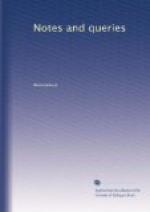“Ay, but to die, and go we know
not where;
To lie in cold obstruction, and to rot;
This sensible warm motion to become
A kneaded clod; and the delighted
spirit
To bathe in fiery floods,” &c.
And if I were to meet with a hundred thousand passages of a similar construction, I am confident they would only confirm the view that the spirit is represented in the then present state as at the termination of the former clause of the sentence. If such had not been the view instinctively taken by all classes of readers, there could have been no difficulty about the meaning of the word.
As a proof that this view of the construction is correct, let L.B.L. substitute for “delighted spirit”, spirit no longer delighted, and he will find that it gives precisely the sense which he deduces from the passage as it stands. If this be true, then, according to his view, the negative and affirmative of a proposition may be used indifferently, in the same time and circumstances giving exactly the same meaning.
MR. SINGER furnishes another instance (Vol. ii., p. 241.) of the value of my canon. I think there can be no doubt that his explanation of the meaning of the word eisell is correct; but if it were not, any way of reading the passage in which it occurs would lead me to the conclusion that it could not be a river. Drink up is synonymous with drink off, drink to the dregs. A child, taking medicine, is urged to “drink it up.” The idea of the passage appears to be that each of the acts should go beyond the last preceding in extravagance:—
“Woo’t weep? Woo’t
fight? Woo’t fast? Woo’t tear
thyself?
Woo’t drink up eisell?”
And then comes the climax—“eat a crocodile?” Here is a regular succession of feats, the last but one of which is sufficiently wild, though not unheard of, and leading to the crowning extravagance. The notion of drinking up a river would be both unmeaning and out of place.
SAMUEL HICKSON.
September 18. 1850.
* * * * *
THE COLLAR OF ESSES.
I shall look with interest to the documents announced by Dr. ROCK (Vol. ii., p. 280.), which in his mind connect the Collar of Esses with the “Sanctus, Sanctus, Sanctus” of the Salisbury liturgy: but hitherto I have found nothing in any of the devices of livery collars that partakes of religious allusion. I am well aware that many of the collars of knighthood of modern Europe, headed by the proud order of the Saint Esprit, display sacred emblems and devices. But the livery collars were perfectly distinct from collars of knighthood. The latter, indeed, did not exist until a subsequent age: and this was one of the most monstrous of the popular errors which I had to combat in my papers in the Gentleman’s Magazine. A Frenchman named Favyn, at the commencement of the seventeenth century, published




